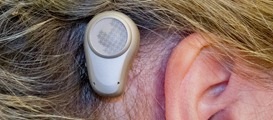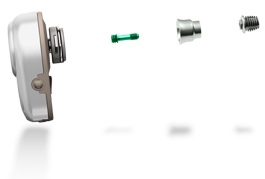Hearing Aids
Appointment Request
Bone Anchored Hearing devices
Bone-anchored hearing devices are surgically implantable systems to treat hearing loss through bone conduction of sound vibrations, in contrast to regular hearing aids, which amplify acoustic sounds that enter the ear canal.

Why bone-anchored hearing devices?
Bone-anchored hearing devices bypass particular problems by sending sound vibration directly to the inner ear through the skull bone. This can be helpful because middle ear and ear canal problems might prevent sound waves and signals from reaching the inner ear along the typical acoustic pathway.
People who suffer from chronic ear infections might find regular hearing aids aggravate their symptoms.
People who are potential candidates include those who have chronic ear infections or allergies, outer or middle ear malformations and those with single-sided deafness.
Chronic ear infections
People with chronic ear infections are sometimes good candidates because they often have continual drainage from their ears. Placing a hearing aid in the ear may exacerbate recurring infection by plugging up the ear canal, whereas a bone-anchored hearing device does not occlude the ear canal. A bone-anchored hearing device is also a potential solution for those individuals who have extreme allergies to the materials used to fabricate custom hearing aids and earmolds.
Malformations of the outer or middle ear
Malformations of the ear canal or middle ear, such as narrowing of the ear canal or a malformed or absent pinna (external ear) cause conductive hearing loss. These malformations are often congenital, or present at birth. A bone-anchored hearing solution works for these individuals because it delivers sound vibrations directly to the inner ear by being in direct contact with the skull bones.
Single-sided deafness
Single-sided deafness (SSD) is a condition in which a person has lost all hearing in one ear, while having anywhere from normal hearing to profound hearing loss in the other ear. Single-sided deafness makes it difficult to determine which direction sound is coming from (localization) and diminishes the ability to understand speech in noisy environments.
People with unilateral hearing loss try to position themselves in lecture halls, classrooms, conversations and dinner parties so that the better hearing ear is directed toward the speaker.
If you have single-sided deafness, you can wear a special pair of hearing aids that route sounds from the poorer hearing side to the better hearing side, but the bone-anchored hearing device may be preferable because it requires the use of only one discreet device.
Other conditions that might warrant a bone-anchored hearing device include:
- Acoustic neuroma
- Meniere’s disease
- Middle ear disease or dysfunction
- Sudden hearing loss
- Cholesteatoma
How does it work?
Bone-anchored hearing devices have three parts: a titanium implant, a sound processor and an external connecting element. During an outpatient procedure that typically takes less than one hour, a small titanium implant – usually only 3 or 4 millimetres – is placed into the bone behind the ear. Over time, it integrates naturally with the bone. A tiny abutment is then inserted and juts out through the skin. A removable microphone and sound processor is then attached to the abutment. Some devices are now using magnetic connections between the processor and implant, like a cochlear implant.

Bone-anchored devices transmit sound through the temporal bone.
After it is implemented, the bone-anchored hearing device works by taking advantage of the bone vibrations, a natural transmission pathway for sound to travel to the inner ear. Rather than delivering acoustic stimuli through the ear canal and middle ear, the sound processor of the bone-anchored device sends vibrations through the abutment (or via electromagnetic coupling) to the implant. In turn, the implant vibrates the surrounding bone, which sets up sound waves in the inner ear that stimulate the hair cells and result in the firing of the auditory nerve.
Because this type of device requires at least one functioning inner ear, it is not recommended for the most common hearing loss that exists, bilateral sensorineural hearing loss. It is a specialty device for those conditions which are described above.
Benefits of bone-anchored hearing devices
The biggest benefit of bone-anchored hearing devices is that they bypass the outer and middle ear structures. This type of hearing solution is the only option for those who have outer or middle ear malformations, allergies or chronic ear infections. Others may choose a bone-anchored device over a traditional acoustic device because the ear canal is not occluded with an earmould, which can lead to a plugged up feeling, trap humidity inside the ear canal and occasionally cause discomfort and infection.
The downside of bone-anchored hearing devices is that they require surgery for implantation, which is expensive. The device placement does not damage the inner ear, so it can be removed if necessary without causing any damage to the patient’s existing hearing ability.
Our Locations
Mount Waverley
(Pinewood Shopping Village)
- Level 1, 407 Blackburn Road
Mount Waverley, VIC 3149 - 03 98867157
- contact@allearshearing.com.au
- Monday: 9:00am – 5:00 pm
Tuesday: 9:00am – 5:00pm
Wednesday: 9:00am - 5:00pm
Thursday: 9:00am – 5:00 pm
Friday: 9:00am - 5:00pm
Saturday: Only on request. Weekend charges apply
Bentleigh East
- 869 Centre Road
- Bentleigh East , VIC 3165
- 03 98867157
- contact@allearshearing.com.au
- Wednesday : 10:30 am – 5 pm
Yarra Junction
- Yarra Junction Arcade
Shop 4/2456 Warburton Hwy
Yarra Junction, VIC 3797 - 03 98867157
- contact@allearshearing.com.au
- Tuesday: 9:30 am - 5:00 pm
Friday: 9:30 am - 5:00 pm



 View on Map
View on Map